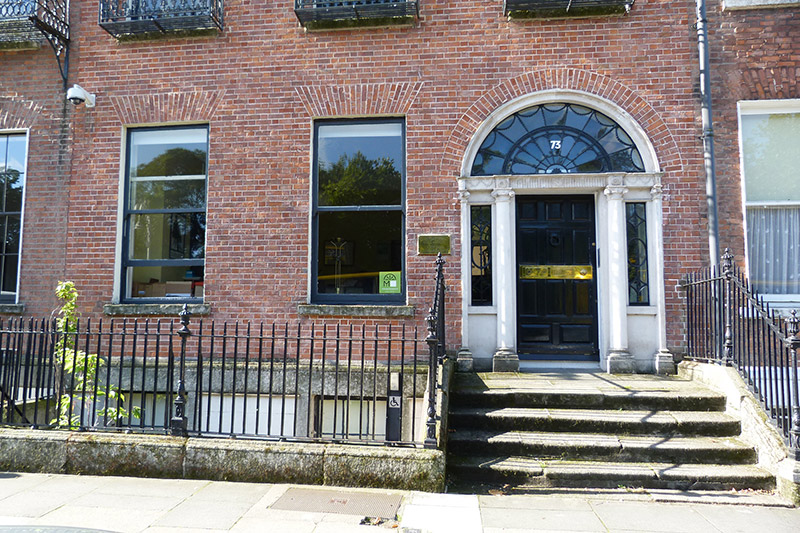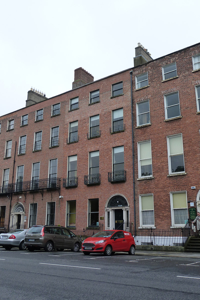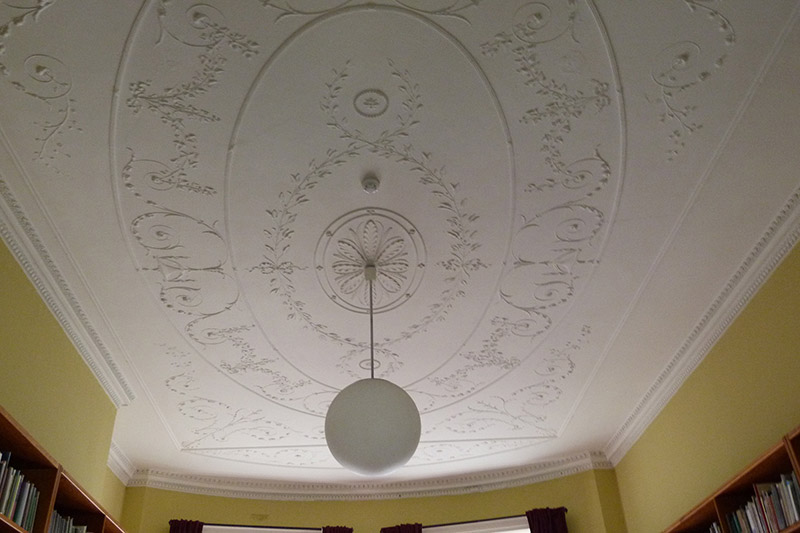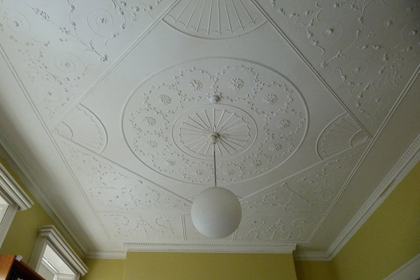Survey Data
Reg No
50100415
Rating
Regional
Categories of Special Interest
Architectural, Artistic
Original Use
House
In Use As
Library/archive
Date
1780 - 1800
Coordinates
316596, 233482
Date Recorded
18/08/2016
Date Updated
--/--/--
Description
Attached three-bay four-storey former house over basement, built c. 1790 apparently as one in terrace of seventeen, having bow to two eastern bays of rear elevation and four-bay two-storey return over basement to rear of third bay. Now in use as archive. Pitched slate roof to front, behind refaced brick parapet with granite coping, and with two hipped roofs to rear perpendicular to street, larger over bow. Shouldered brick and rendered chimneystacks with clay pots. Replacement uPVC rainwater goods to west end of front, and cast-iron rainwater goods to rear. Flemish bond brown brick walls to front elevation, refaced above mid-point of top floor window level, with granite plinth course over painted rendered walls to basement; rear elevation is yellow brick. Square-headed window openings, diminishing in height to upper floors, with painted granite sills; carved granite block-and-start surrounds to basement. Timber sliding sash windows, front elevation having six-over-six pane without horns to basement, and replacement one-over-one pane elsewhere; rear has three-over-three pane to top floor, two-over-two pane to second floor and one-over-one pane to lower floors; addition has some round-headed window openings. Ornate cast-iron balconettes to first floor and wrought-iron window-guards to second floor. Round-headed main entrance doorway with rendered linings, fluted frieze and cornice, engaged Ionic columns with respond pilasters flanking decorative leaded sidelights, batwing fanlight and eleven-panel timber door with brass furniture. Granite platform with four granite steps. Wrought-iron railings to basement area with decorative cast-iron posts on carved granite plinth. Cast-iron coal-hole cover set in granite flag to pavement. Entrance hall has flagged floor, timber dado rail, shallow plasterwork cornice, neo-Classical plasterwork ceiling, square-headed door openings with moulded timber architraves and timber panelled doors; stairs hall has open-string staircase with wrought-iron balusters and mahogany handrail, panelled walls and neo-Classical plasterwork ceilings; ground floor rooms have timber chair rail, chimneypieces to east wall, square-headed door openings with timber surrounds, decorative over-doors and timber panelled doors, swagged plasterwork cornice, plasterwork ceiling roses, and square-headed window openings with timber panelled soffits and shutters; first floor rooms have square-headed door openings with timber architraves and timber panelled doors, and shallow neo-Classical plasterwork ceilings. carparking to rear. Three-bay two-storey mews building to Fitzwilliam Lane.
Appraisal
No. 73 Merrion Square is an elegant Georgian house that forms part of the eighteenth-century square developed by the Fitzwilliam Estate. The plot was leased by James Doyle from Lord Fitzwilliam; following its completion c. 1792 it was occupied by William Stratford. The relatively sober facade is enhanced by its elegant tripartite doorcase and further decorative interest is added by the ornate balconettes. The interior is heavily ornamented with low profile neo-Classical plasterwork throughout, including the stairs hall and stair soffits. The railings also provide visual and craft interest. The building and its intact setting details contribute significantly to the intact appearance of this internationally important architectural set-piece. The square is one of the best-preserved Georgian streetscapes in Ireland. The north, east and south sides are lined with terraced houses of eighteenth and early nineteenth-century date, while the west side is terminated by the garden front of Leinster House. The houses maintain a relatively uniform building height and design, attributed to standards promoted in Fitzwilliam's leases. Individuality was introduced through the design of doorcases, window ironwork and interior decorative schemes. The south side was initially set in large plots of twelve leases; plots were leased consecutively from east to west up until the row was completed in 1791.







































